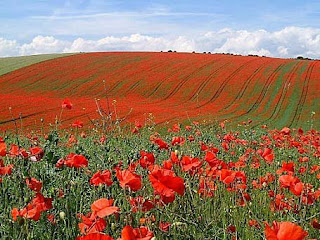St. Andrew the Apostle, 30 November
The next day John [the Baptist] was there again with two of his disciples. When he saw Jesus passing by, he said, “Look, the Lamb of God!” When the two disciples heard him say this, they followed Jesus. Turning around, Jesus saw them following and asked, “What do you want?” They said, “Rabbi” (which means “Teacher”), “where are you staying?” “Come,” he replied, “and you will see.” So they went and saw where he was staying, and they spent that day with him. It was about four in the afternoon.
Andrew, Simon Peter’s brother, was one of the two who heard what John had said and who had followed Jesus. The first thing Andrew did was to find his brother Simon and tell him, “We have found the Messiah” (that is, the Christ). And he brought him to Jesus. Jesus looked at him and said, “You are Simon son of John. You will be called Cephas” (which, when translated, is Peter). (John 1:35-40)
In the Eastern tradition, Andrew is often called “the first-called (protokletos)” because of this story in the Gospel of John, where Andrew and the unnamed John (the Beloved) are described as disciples of John the Baptist who first became followers of Jesus. Andrew is the one who introduces his brother Simon Peter to Jesus. Andrew and Peter were both fishermen from Capernaum, who were called by Jesus to become “fishers of people.”
The name Andrew is actually a Greek name, meaning “manly.” A measure of the degree of intra-cultural mingling and convergence in the mixed populations of Galilee of the period is found in the popularity of such Greek names for Jewish boys there. This, even in the presence of wildly popular but such stridently nationalistic Jewish names such as Simon, Judas (Judah), and Jesus (Joshua).
Later in John’s Gospel, when a group of Greeks (or Greek-speaking Jews) wish to speak with Jesus, it is Philip and Andrew they approach, both disciples with Greek names (John 12:20-22; “Philip” means “horse lover”).
Earlier in John, when Jesus realizes the crowds are hungry just before he feeds the Five Thousand, it is Andrew who introduces him to a boy nearby by saying, "Here is a lad with five barley loaves and two fish." (Jn 6:8f)
Andrew appears in all the various lists of the Twelve given in the New Testament, but these three passages in John are the only places where we see Andrew as an individual. In each, he is portrayed as introducing people to Jesus. As a result, he is seen as the archetype of the Christian missionary or evangelist. The Fellowship of Saint Andrew among Episcopalians today is devoted to encouraging personal evangelism, bringing of one's friends and colleagues to a knowledge of Christ.
Since Andrew is seen as the first of the Apostles, his feast on November 30 marks the beginning of the Church Year. The First Sunday of Advent is defined as the Sunday on or nearest the Feast of St. Andrew. This day is effectively the fourth Sunday before Christmas Day.
In early Church tradition, Andrew preached in Asia Minor and along the Black Sea, and was martyred by crucifixion in Greece. Tellingly, later tradition describes him not nailed to a Latin cross, like Jesus, but rather, tied to an X shaped cross (a “saltire”), where he valiantly preaches for two days before expiring.
When the Emperor Constantine in the 4th century set up his new capital Constantinople at Byzantium, the bishopric of the new city needed the cachet and authority of an appeal to apostolic tradition like those of the other major metropolitan sees or patriarchates. Rome and Antioch both claimed that their churches had been founded by Peter and Paul; Alexandria, Mark, Peter’s assistant and scribe; Jerusalem, all the Twelve as well as James the brother of the Lord. The Patriarch of Constantinople reached back to the traditions of Andrew preaching along the Black Sea and the Bosporus to claim such status for his see. The great Byzantine preacher John Chrysostom said that thus Andrew, the first-called of the apostles, the “Peter even before there was a Peter” founded what he claimed was the preeminent Patriarchate in the Church.
Since missionaries went far and wide from Constantinople, soon Andrew was claimed as patron saint of Ukraine, Romania, Russia. In the early Middle Ages, a missionary named Rule brought some of Andrew’s relics to Scotland, to a town known as Fife, but which he rechristened as St. Andrew's, where there is now the oldest and most famous course for Scotland’s national sport, golf. Andrew thus became the patron saint of Scotland in addition to the Greek Byzantine heritage countries where he himself had been a missionary.
The white X shaped saltire “St. Andrew’s Cross” on a blue field is the design of the Scottish national flag. The St. Andrew's cross appears in the Union Jack of Great Britain behind the red X shaped cross of St. Patrick of Ireland and the regular +-shaped red cross of St. George, patron saint of England.
Most Merciful God, you make yourself known in the lives and examples of your saints. Bestow on us, we pray you, the courage and loving friendly concern of your first apostle, Andrew, that we, like him, may stand as constant witnesses of your love, grace and truth, and bring our friends and colleagues to the knowledge and love of Jesus Christ your son our Lord, in whose name we pray. Amen.


















